25 November, 2003
Still Waiting
--
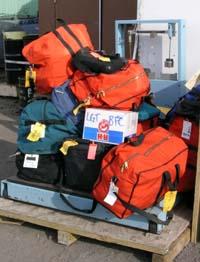
1. Figure 1 – At 8:45 AM we toted all of our gear down to the Helo-pad and weighed it in for the flight. We are allotted 500 pounds of gear per flight.
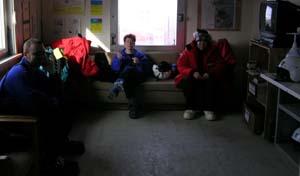
2. Figure 2 – Here we are sitting patiently in the Helo-pad waiting room. We’re dressed in our ECW gear and even have our helmets ready for the flight.

3. Figure 3 – Our first flight was scheduled for 9:45 this morning.

4. Figure 4 – Well, cards are a good way to kill some time. Hearts anyone? No – solitaire it is then.

5. Figure 5 – With some time to spare, Kurt talks to a “tour” group visiting the Crary Lab. He explains what work is being done within the Erebus project and describes what is visible on the monitors. The TV screen shows a live-feed view of the inner crater, which is often too steamy for a good view of the lava lake. The two computer monitors show real-time seismic data on the top screen and mpeg videos of past eruptions on the bottom. These videos can be seen on the MEVO (Mt. Erebus Volcano Observatory) web page at http://www.ees.nmt.edu/Geop/mevo/mevo.html

6. Figure 6 – It’s looking doubtful that we’ll fly today.
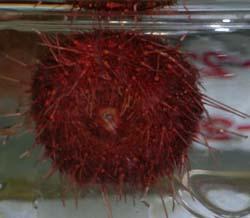
7. Figure 7 - Once our flight was officially canceled, I took advantage of the opportunity to wander around the Crary Lab and find out what other projects were going on. Graduate student Lindsay Kendall was kind enough to spend some time explaining the sea urchin project to me. Working with Dr. Adam Marsh at the University of Delaware ( http://marsh.cms.udel.edu ), Lindsay helps culture sea urchin embryos in the lab. Divers collect sea urchins early in the season and then the fertilized urchin eggs are monitored throughout each stage of development, from zygote to juvenile. Because the Antarctic water is so cold (approximately 1.5 degrees Celsius), the rate of urchin development is dramatically slowed. The first division of the zygote occurs 8 hours after fertilization, a process that takes a matter of minutes under normal temperatures. Each successive cell division occurs 6 hours after the last. At this rate, it takes a Sterechinus neumayeri egg 150 days to develop at cold temperatures. In addition to reproductive studies, the team also looks at gene expression at each stage of development. Because development of the urchin embryos is so slow, there is a wide window of opportunity to study which genes are turned on or off in each stage. --
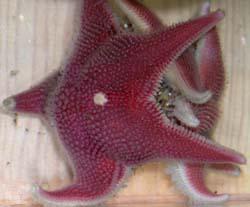
8. Figure 8 - Other projects examine the wide variety of critters that call the Antarctic waters home ( www.mcmurdo.gov/science/fieldguide/index.html ). This is a species of sea star called Odontaster validus, which is a voracious predator. Many Odontaster will mob a victim and evert their stomachs onto their prey, which may be urchins, other sea stars, or even the occasional dead fish, until they dissolve away the animal's flesh. --
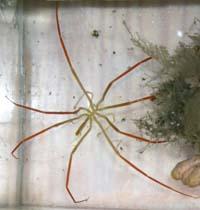
9. Figure 9 – A long-legged sea spider of the genus Colossendeis “scurries” around the bottom of the tanks at the Antarctic equivalent of a sprint. Movement is slowed in cold waters to conserve energy. Most organisms spend a great deal of time resting on the bottom of their tanks. Sea spiders are also called pycnogonids or whip scorpions. There are 251 species of Antarctic and subantarctic sea spiders, which comprise 21.5% of worldwide species.

10. Figure 10 – A bright yellow sea star, an orange sea cucumber, and a tiny gold isopod cozy up to each other in a shallow tank.

11. Figure 11 – Bearing a remarkable resemblance to the beloved cockroaches that I regularly find migrating through the house in Texas, the Giant Antarctic Isopod is a formidable presence in the touch tank. Glyptonotus antarcticus is found throughout Antarctica, the Antarctic Peninsula, and surrounding islands at depths ranging from intertidal to 790 meters. The Giant Isopod can grow to twenty centimeters in length and may live from five to eight years. As a benthic (bottom-dwelling) predator and omnivorous scavenger, the isopod shares the same ecological niche as lobsters and crabs which live in temperate waters.
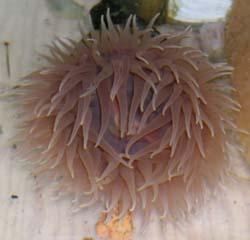
12. Figure 12 – An anemone gently rocks back and forth in the current as water is circulated in the tank to keep the organisms well oxygenated.
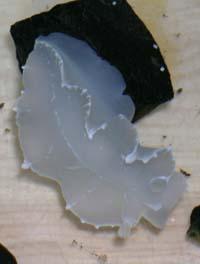
13. Figure 13 – Delicate, lacy nudibranchs seem to defy the odds of survival in the harsh, cold Antarctic waters.
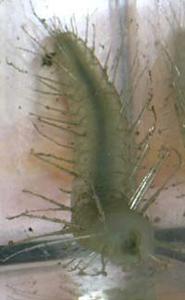
14. Figure 14 – At about 8 cm long, this critter looks like a miniature version of a horror film monster. Flabelligera mundata is found throughout Antarctica and the Antarctic Peninsula and New Zealand at depths of 6 up to 594 meters. These worms can grow up to ten centimeters long with a width of three centimeter.
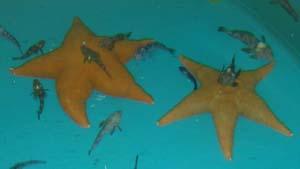
15. Figure 15 – Two enormous sea stars slowly make their way around the bottom of their tank. Measuring approximately 30 cm across, arm tip to arm tip, these colorful giants are always in search of their next meal.

16. Figure 16 – Enormous Antarctic cod, Dissostichus mawsoni, lazily swim around their holding tank. These fish can exceed 200 pounds and live more than 40 years. Deep, benthic dwellers, these fish were caught at a depth of about 450 m (1500 feet).
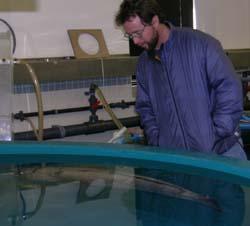
17. Figure 17 – With a person in the photo for scale, the massive size of these predatory fish is apparent.
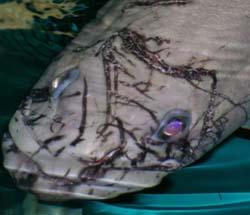
18. Figure 18 – Over a meter long, the largest of the three cod in the aquarium shows many scars on his head. These may be the results of run-ins with the Weddell seals or Orca whales who typically prey on the cod. Note the large eyes, an adaptation to living in low-light conditions.

19. Figure 19 – Despite being a favorite prey of seals and Orcas, the cod are well armed to defend themselves. A sign hangs over the live cod in the aquarium warning visitors to “Please respect these fish, they do have sharp teeth.” One look at the skull of a mawsoni in the lab display case reveals this to be an understatement!

20. Figure 20 – Graduate student John Morrison from Creighton University in Omaha, Nebraska, a member of Dr. David Petzel’s team, found some time to talk with me about Trematomus bernacchii, one of the species of ice fish. The fish are resistant to freezing despite the fact that they live in water that is a relatively constant -1.86 degree Celsius, barely above the freezing point of salt water. This resistance is accomplished with special antifreeze glycopeptides in its body fluids that bind to emerging ice crystals and prevent their growth. T. bernacchii are so well adapted to cold water that they actually die at temperatures in excess of 6 degrees Celsius, the lowest heat depth temperature of any animal. Dr. Petzel’s team is also looking at salt levels in the fish blood. Temperate fish have levels of 300 g NaCl per liter of water. T. bernacchii’s salt level is 580 g/l. This increased salt level is believed to aid in the antifreeze process as salt decreases the freezing point of liquid. Interestingly, when the fish are warmed to 4 degrees Celsius, their blood salt level decreases to about 400 g/l. The team is studying a protein in the fish gills that may help to remove the unnecessary salt.

21. Figure 21 – Dinnertime at the aquarium. The fish are not fed during the study as feeding changes the rate of water intake and therefore the salt levels in the fish’s body. To get a better understanding of how temperature affects salt level, food is withheld from the fish, causing some fish to take matters into their own mouths. Time for my own dinner, a quick lecture on deformation on Mt. Erebus, and then off to bed to dream about flying to Fang Camp.
Contact the TEA in the field at
.
If you cannot connect through your browser, copy the
TEA's e-mail address in the "To:" line of
your favorite e-mail package.
|

























